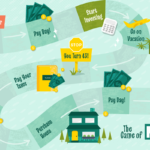(Sponsor Content)
Your ideal investing strategy when you’re 25 just is not the same as when you’re 52.
That’s because what you earn is partly a function of what you’ve already managed to acquire. In Canada, about 85% of all financial assets are in the hands of people over age 45. Pension assets are held in the same proportions. On the real estate front, just 32% of all real estate value is in the hands of those under age 45. Meanwhile, fewer companies today offer a pension plan of any kind. The defined benefit pension plan is on its way to extinction.
What’s a young person to do? And for older investors who are going to retire earlier, how should their investment strategy change? What are the lessons that need to sink in when it comes to investing for people over or under 45?
What’s the investment strategy for Canadians under 45? Lower your fees!
You’re finished with school (at least for now). You’ve entered the job market and you’re starting to build up some savings. You’re diligently putting between 10 and 20 per cent of your salary into an RRSP. The younger you start to contribute to an RRSP, for instance, the sooner you can take advantage of compound interest.
Regardless, you want a good return on your investment and maybe you’ll get lucky and enjoy a bull market.
You can’t actually control that return, even if you’re investing in your own company … but if you’re using an investment platform like WealthBar or a traditional firm, you definitely can control how much you pay in fees.
For instance, with a WealthBar account, an investor might pay about 0.6% in management fees to WealthBar, versus 2.2% for a mutual fund at a bank. Put another way, an investor might pay $10 a month for WealthBar to manage $25,000, versus nearly $46 per month with a typical bank mutual fund.
Fees add up! While it may seem like the older generation controls the vast majority of assets (OK, they do), young people can at least control how much they pay a firm to manage their account. The right choice can literally save hundreds of thousands of dollars in value that would otherwise pad a financial adviser’s pocketbook.
But, should you race to the bottom? Perhaps not. Ensure that your strategy is still sound and diversified in order to achieve your goals in time. So, do not invest all your money into that 0.05% US Equity ETF. Some fees are ok, if they provide value such as diversification, cash flow, currency alignment and liquidity.
What’s the investment strategy for Canadians over 45? Reduce your risk!
Perhaps you’re one of the lucky Canadian investors over 45 who has had a good run. A pride-inducing chunk of that 85% chunk of financial assets are in your account.
You’ve been in this game long enough to instantly recall the nausea-inducing market free-fall of 2008-2009. Maybe you got burned when the dotcom bubble burst in 2000-2001. You were also there as the market bounced back, taking solace in the historical fact of market gravity: what goes down must come up (eventually).
But what goes up must come down. You don’t know when or why. But eventually, there will be a correction in the market. If that happens in the years right before you retire, you could see a big chunk of your life savings melt away, just as you’re forced to start withdrawing funds from your RRSP. Your focus must be on preserving wealth!
One specific suggestion: for investors over 45, one option could be to place funds in a WealthBar’s Private Investment Portfolios. It is designed to lower volatility, with diversification and cash flow; they provide market comparable steady returns at less than half the volatility of a balanced mutual fund.
Got some bonus advice for investors over 45?
We sure do! When you’re looking for ways to protect your investment, keep these rules in mind:
- Understand how much you need to save to maintain the same standard of living in retirement. You should already know, from talking to your financial adviser. But circumstances change: make sure those numbers are up-to-date.
- Park that money on a tax deferred basis into a pension-like investment. (Until recently, this type of investment strategy was only accessible to a retail investor of sufficient assets or inside a sophisticated life insurance policy. WealthBar makes this possible for everyone.)
Finance 101 lesson overview: Investing for people over or under 45
Young people who are still in a primary wealth-building phase need to pay attention to fees and keep them as low as possible. Long-term, savings in fees can translate into significant extra resources in retirement – or maybe even taking retirement early!
Older investors can still keep growing their assets, but they need to pay more attention to volatility. They should reduce their exposure through diversified investments, to ensure that they don’t get hurt too badly in a market downturn as they head into retirement.
 Tea Nicola is CEO and Co-founder of WealthBar Financial Services based out of Vancouver. As a fintech entrepreneur, mentor and public speaker, she’s passionate about making it easier for Canadians to invest. This blog originally appeared on the WealthBar website in July 2017.
Tea Nicola is CEO and Co-founder of WealthBar Financial Services based out of Vancouver. As a fintech entrepreneur, mentor and public speaker, she’s passionate about making it easier for Canadians to invest. This blog originally appeared on the WealthBar website in July 2017.


